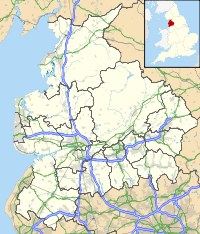- St Oswald's Church, Warton
-
St Oswald's Church, Warton 
St Oswald's Church, Warton, from the northwestCoordinates: 54°08′39″N 2°46′10″W / 54.1442°N 2.7694°W OS grid reference SD 498 723 Location Main Street, Warton, Lancashire Country England Denomination Anglican Website St Oswald, Warton History Dedication Saint Oswald Architecture Status Parish church Functional status Active Heritage designation Grade II Designated 2 May 1968 Architect(s) Sharpe and Paley
Paley, Austin and PaleyArchitectural type Church Style Gothic, Gothic Revival Completed 1892 Specifications Spire height 62 feet (19 m) Materials Pebbledash with sandstone dressings, slate roof Administration Parish St Oswald, Warton Deanery Tunstall Archdeaconry Lancaster Diocese Blackburn Province York Clergy Vicar(s) Rev D. M. Porter Laity Reader Dr M. E. Coles Churchwarden(s) Mr J. R. Ogden,
Mr C. J. HopwoodSt Oswald's Church, Warton, is in the village of Warton, Lancashire, England. It is an active Anglican parish church in the deanery of Tunstall, the archdeaconry of Lancaster, and the diocese of Blackburn.[1] The church has been designated by English Heritage as a Grade II listed building.[2]
Contents
History
The present church is probably built on the site of a church in existence prior to the 12th century. It was largely rebuilt in the 15th century, retaining part of the wall of the south aisle.[3] The north aisle was either added or rebuilt in the 16th century.[4] In 1848–49 renovation work was carried out on the south arcade by the Lancaster architects Sharpe and Paley.[5] More extensive restoration work was carried out in 1892 by Paley, Austin and Paley, successors to Sharpe and Paley.[3] This consisted of renewing windows in the clerestory, the north aisle and elsewhere, and reconstructing the roof.[4] The church has historical connections with the Washington family,[3] ancestors of George Washington, first president of the United States.[6]
Architecture
Exterior
The church is pebbledashed with sandstone dressings, and has a slate roof. Its plan consists of a west tower, a nave with north and south aisles and a clerestory, and a chancel. The tower has angle buttresses, three-light bell openings, and a battlemented parapet with corner pinnacles. The former west door has been partly blocked, making it into a window, and over this is a small niche.[2] The tower is 62 feet (19 m) high.[4]
Interior
The tower once bore the arms of the Washington family, but these have been moved and are now re-set inside it.[2] The tower holds three bells, hung for full circle ringing, but currently unfit to be rung. The second bell dates from 1571, the tenor from 1731, and the treble from 1782. The second and the frame in which the bells are hung are considered to be of historical significance.[7][8] In the southeast chapel is a sedilia that is considered to date from the late 13th or early 14th century. The font is cylindrical and lead-lined, and carries the date 1661. Incorporated into the 19th-century pews are coats of arms, one of these being of the Washington family that is dated 1614. In the southwest aisle are the arms of Queen Victoria. In the church is stained glass by Shrigley and Hunt, Ward and Hughes, and F. Burrow, and memorial wall tablets by George Webster. There is more stained glass in the vestry by Shrigley and Hunt; this depicts Saints Oswald, Patrick and Aidan.[3]
See also
- List of works by Sharpe and Paley
- List of works by Paley, Austin and Paley
References
- ^ St Oswald, Warton, http://www.achurchnearyou.com/warton-st-oswald-or-holy-trinity/, retrieved 22 June 2010
- ^ a b c Images of England: Church of St Oswald, Main Street, Warton, English Heritage, http://www.imagesofengland.org.uk/details/default.aspx?id=182018, retrieved 22 June 2010
- ^ a b c d Hartwell, Clare; Pevsner, Nikolaus (2009) [1969], The Buildings of England. Lancashire: North, New Haven and London: Yale University Press, p. 681, ISBN 978 0 300 12667 9
- ^ a b c Farrar, William; Brownbill, J., eds. (1914), The parish of Warton, Victoria County History, pp. 151–161, http://www.british-history.ac.uk/report.aspx?compid=53286, retrieved 22 June 2010
- ^ Price, James (1998), Sharpe, Paley and Austin: A Lancaster Architectural Practice 1836–1942, Lancaster: Centre for North-West Regional Studies, p. 71, ISBN 1-86220-054-8
- ^ History of the family of "Washington", AncestryUK, http://www.ancestryuk.com/WashingtonAncestry.htm, retrieved 22 June 2010
- ^ "Warton—S Oswald or Holy Trinity", Dove's Guide for Church Bell Ringers, 24 June 2009, http://dove.cccbr.org.uk/detail.php?searchString=Warton&Submit=++Go++&DoveID=WARTON, retrieved 23 June 2010
- ^ "Database of historically significant bells and bellframes", Church of England Churchcare website, 29 October 2007, http://www.churchcare.co.uk/bells.php, retrieved 23 June 2010, "enter "Warton" in "Parish or Location" text box, and click "Search""
Categories:- Church of England churches in Lancashire
- Grade II listed churches
- Grade II listed buildings in Lancashire
- 15th-century architecture
- 16th-century architecture
- Religious buildings completed in 1892
- 19th-century Church of England church buildings
- Gothic Revival architecture in England
- English Gothic architecture
- Diocese of Blackburn
- Sharpe and Paley buildings
- Paley, Austin and Paley buildings
- Buildings and structures in Lancaster
Wikimedia Foundation. 2010.

